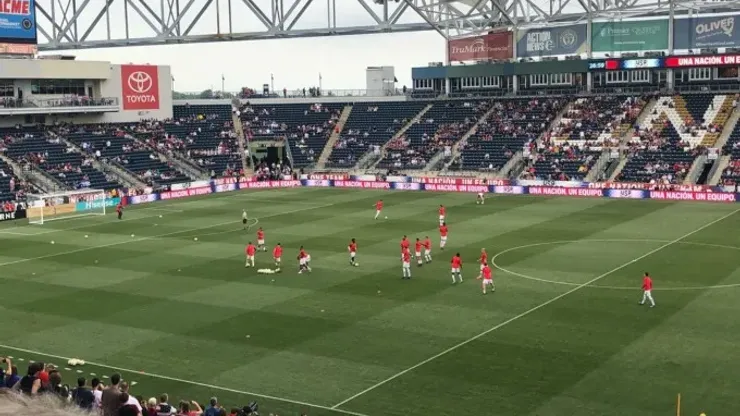World Cup years are typically a boon for US Soccer. Attendance goes up, TV ratings increase, and revenue skyrockets. Of course, for all of that to happen, you have to qualify for the World Cup. The US did not. Predictably, interest in the team from casual and hardcore fans plummeted.
It wasn’t just that the US missed the World Cup, though that was certainly a huge factor. The coaching search that took 14 months to name a milquetoast manager also angered and frustrated many fans. US Soccer and SUM may try to paint a rosy picture, but the reality is that attendance is down and has been going down for several years now because of their incompetent leadership.
Here’s the 2018 USMNT attendance for home matches:
1/28/18 – Friendly – USA vs. Bosnia & Herzegovina – StubHub Center – 11,161
3/27/18 – Friendly – USA vs. Paraguay – WakeMed Soccer Park – 9,825
5/28/18 – Friendly – USA vs. Bolivia – Talen Energy Stadium – 11,882
9/7/18 – Friendly – USA vs. Brazil – MetLife Stadium – 32,489
9/11/18 – Friendly – USA vs. Mexico – Nissan Stadium – 40,194
10/11/18 – Friendly – USA vs. Colombia – Raymond James Stadium – 38,631
10/16/18 – Friendly – USA vs. Peru – Pratt & Whitney Stadium – 24,959
• Total Attendance: 169,141
• Average Attendance: 24,163
The 24,163 average in 2018 represents a 17% drop from 2017 and was the lowest attendance since 2006 when they averaged 20,360 per game. The year 2018 was the third straight year where the US Men’s National Team (USMNT) averaged less than 30,000 fans per game, a feat that was last accomplished from 2004 to 2006. The year 2018 also marked the third consecutive year of attendance decline as the average dropped from 38,763 in 2015 to 29,707 in 2016, then dropped to 29,400 in 2017 and now down to 24,163 in 2018. Since 2015, US attendance has fallen off by 37%. It’s worth noting that in each of the last two World Cup years, we saw solid average attendances: 34,374 in 2014 and 35,677 in 2010. And finally the game against Paraguay was the seventh game since 2015 to draw under 10,000 people.
SEE MORE: Mexico’s average attendance in USA 59% greater than USMNT in 2018
One thing that these numbers don’t account for is the number of fans of opposing teams that show up at games and skew the averages. The final four home games of the year all saw crowds that were substantially in favor of the opposing team especially the Mexico game in Nashville and the Colombia game in Tampa. In those games, it was virtually all away fans, save for the American Outlaws behind the goal.
SEE MORE: USSF continues string of mistakes with Gregg Berhalter hiring
So why the historically bad attendance? Missing the World Cup definitely soured a lot of people on the team. It also meant that there was nothing for fans to get excited about for quite some time (the US doesn’t have a competitive game again until the Gold Cup in June, 2019 so that means 19 months of nothing but friendlies.) The 14-month coaching search also played a part in fans checking out on the team. And US Soccer can be as bullish on the Gregg Berhalter hire all they want, but it’s not a hire that gets a fan base excited enough to buy more tickets and go to more games. And of course, another huge issue is the insanely exorbitant ticket prices that have become the norm since after the 2015 Gold Cup. It’s not quite clear why US Soccer can’t figure out that charging $100 for a weeknight friendly against a minnow isn’t filling up a stadium (or even half a stadium). Logic would suggest that US Soccer could make much more money on a full stadium that they could on one that’s only 30% full, but then again we’re not an Ivy League economics professor like Sunil Gulati.
SEE MORE: USWNT average attendance declines 22% in 2018
US Soccer can try to act like missing the World Cup wasn’t a big deal. They can try to flaunt hip new slogans like Kickoff Series or The Future Is Us, but the reality is that the fans are fed up with the federation and fed up with losing. They are no longer willing to pay astronomical prices for an ever decreasing return on investment. Attendance is the lowest it’s been in twelve years. It’s down for a third straight year. How much lower can it go?
200+ Channels With Sports & News
- Starting price: $33/mo. for fubo Latino Package
- Watch Premier League, Women’s World Cup, Euro 2024 & Gold Cup
The New Home of MLS
- Price: $14.99/mo. for MLS Season Pass
- Watch every MLS game including playoffs & Leagues Cup
Many Sports & ESPN Originals
- Price: $10.99/mo. (or get ESPN+, Hulu & Disney+ for $14.99/mo.)
- Features Bundesliga, LaLiga, Championship, & FA Cup
2,000+ soccer games per year
- Price: $5.99/mo
- Features Champions League, Serie A, Europa League & Brasileirāo
175 Premier League Games & PL TV
- Starting price: $5.99/mo. for Peacock Premium
- Watch 175 exclusive EPL games per season






